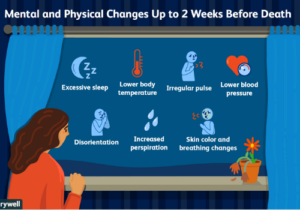Many people are unfamiliar with the process of death. Patients and caregivers who are terminally ill may wonder what to expect during this stage and how to make it more comfortable. Understanding what happens during this process can help everyone involved better prepare for this transition and each stage of death. How do you know the understanding the stages of death?

The Three Major Stages of Dying
There are three major stages of death: the first, the middle, and the last. These are distinguished by a variety of changes in responsiveness and functioning. However, it is important to note that the timing of each stage and the symptoms experienced can differ from person to person. A general overview of what to expect at each stage is provided below.
Early Stages of Death
A patient in the early stages of dying will begin eating and drinking significantly less. This period can range from a few days to several weeks.
What You Will Discover
The first sign of this stage of death will be a noticeable decrease in appetite. At this point, eating becomes more of a chore than a pleasure for many patients. They may also choke on their fluids occasionally and become full quickly. Oasis hospice is the best hospice for veterans.
Reduced Energy
During this stage, the body begins to conserve energy and does not require as much nourishment as previously. Although it is upsetting to witness, it causes no pain or suffering to the patient. This is a natural process in which the body suppresses hunger, and artificial feeding at this time does not prevent death and may even cause physical discomfort. To provide comfort, loved ones can offer patients bites of food, sips of fluid, or ice chips, but it is critical to respect the patient’s eating and drinking preferences.
- Dying in the Middle
- A caregiver converses with a dying patient.
- The patient’s physical appearance may change for a few hours or several days during the middle stage of dying.
You’ll Notice These Signs.
The person will become increasingly unresponsive to their surroundings and those around them, eventually unable to speak or move. This is most common in the final days of life.
What Happens in Stage 2
- Blood is reserved for helping major internal organs function as the body’s circulation slows. The patient’s hands and feet may become cold and darker in appearance.
- During this stage, loved ones can offer blankets to the patient to increase comfort as his or her circulation changes. Heating pads and electric blankets, on the other hand, are not recommended because the patient will be unable to tell if they are becoming too hot.
- Detachment from their surroundings and relationships is a perfectly normal physical and spiritual response to the process of dying.
- Family members should assume that the patient can hear everything they say. Experts advise speaking softly to the patient and gently touching them only if they normally enjoy being touched. This is an excellent opportunity for prayer or meditation. It is not advisable to ask the patient open-ended questions.
The Final Stages of Death
- The patient is lying in bed, with the caregiver holding their hand.
- Disorientation and restlessness will increase in the final stages of dying. The patient’s breathing and continence will be significantly altered.
What You Will Discover
Bowel movements may cease completely, or the patient may become incontinent. As death approaches, their breathing may become shallow and irregular, with long pauses that become more frequent. In the final hours, there may be sounds of chest congestion and throat rattling.
How Their Bodies Are Behaving
The restlessness observed at this stage is attributed to changes in metabolism, while decreased circulation affects kidney and bowel functions. Muscle relaxation can result in incontinence. As blood circulation to internal organs slows, the lungs lose their ability to clear out fluids, and the throat muscles relax. When a patient near the end of their life, it is beneficial to speak to them reassuringly. If the patient enjoys being touched, gentle touch is acceptable. Even if they are not responding, the patient may be able to hear those around them, so speak respectfully. Although this can be difficult for loved ones, it is best to remain calm. Some patients may require restlessness medication, diapers, a catheter, or underbody pads. At this point, administering oxygen will be ineffective. However, elevating the head of the patient’s bed or using pillows to help lift their head may be beneficial; turning the patient on their side may also increase comfort.
Discuss the Stages of Dying with Hospice Care.
If your loved one has a terminal illness, hospice care can help them have a better quality of life in their final months. Contact the Oasis Hospice to learn how they can assist your family and loved one physically, emotionally, and spiritually every step of the way.
Signs 40 Days Before Death
Every death is unique, but home hospice patients typically experience several stages of symptoms before passing away.
SYMPTOMS IN THE WEEKS BEFORE DEATH
Your loved one may exhibit various behavioral changes relating to their sleeping patterns, eating habits, and sociability several weeks before death. They may begin to sleep more frequently and for longer periods. They will initially refuse foods that are difficult to eat or digest but eventually refuse all solid foods. Attempting to force them to eat will only cause them discomfort. During this time, your loved one may enjoy ice because it will keep them cool while also hydrating them. Unfortunately, your loved one may withdraw, become less active, and communicate less. They may prefer to spend more time alone introspecting and may decline company. Some appear comatose and unresponsive, but this is a withdrawal symptom. Because your loved one can still hear you, speak calmly and reassuringly while holding their hand. Even if they withdraw from other activities, children may become more talkative. During this time, it’s critical to let your loved ones go at their own pace. Your loved one may also use metaphorical language to cope with death. It may also refer to a task they believe they must complete, such as seeking forgiveness.
Physical changes that occur during the last stages of the death period are also common symptoms.
- Chronic exhaustion
- Infection susceptibility has increased.
- Skin that is easily damaged
- Pain in general
- Long-term, unexplained weight loss
- Swallowing Difficulties
- Nausea that is untreatable
- Abdominal swelling, such as edema or ascites
SYMPTOMS IN THE DAYS BEFORE DEATH
A series of physiological changes will occur in the days leading up to death. Their pulmonary system will begin to degrade and become congested, resulting in a distinct “death rattle.” Their breathing will also fluctuate, as they may start breathing up to 50 times per minute or as little as six. They may “puff” their lips when exhaling. They may also begin to cough more frequently, but the congestion is generally painless. During their final days, your loved one may begin to have hallucinations in which they converse with people who aren’t present or have died. If your loved one exhibits these symptoms, you must watch them closely. There is no way of knowing how much time they have left; some people go through this process faster than others.
Some common symptoms experienced by those within a few days of death include:
- A decrease in blood pressure
- The body’s temperature fluctuates frequently.
- Skin discoloration or blotchiness
- Sleeping patterns that are erratic
- Less bowel movement
- fewer urinations
- Reduced appetite and fluid intake
Oasis Hospice offers the best hospice care facilities in your town. Do you want to learn more about signs of approaching death, then learn this in another post? You can contact us anytime without hesitation. For more information, call us at708-564-4838.

